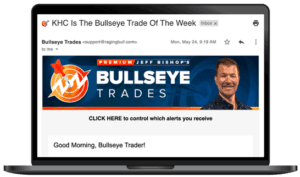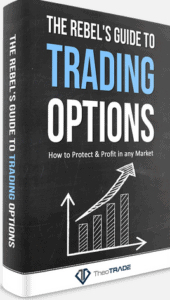Stock Options Basics
Stock Options Basics
A stock option gives the right but not an obligation to trade a specific number of shares (typically 100 shares per option contract) of the company’s underlying stock at a pre-set price and date.
Options contracts are derivatives because their value is derived from the underlying stock’s price. Unlike regular stocks, options are traded as contracts and each stock options contract guarantees the option holder (contract buyer or seller) one hundred shares of the underlying stock.
Few traders actually exercise their options and instead trade them before they expire.
That is because you don’t have an obligation to actually trade the underlying stock at the expiration date; however, once the option goes beyond the expiration date, it’s rendered invalid and the option can no longer be exercised.
Disclaimer: There are affiliate links on this page. This means that if you click through and purchase anything, I might earn a commission for the introduction with no extra cost to you.
Come and join my Stock Alerts Reviewed Facebook Group HERE!
Limited Time Deal to Purchase Nate Bear’s Profit Surge Trader ASAP HERE
You can also watch a full interview with Nathan Bear discussing the Profit Surge Trader system here.
*******************************************
Investing Wizard Who Turned $37K Into $2.7M in Just 4 Years Makes His Next Big Move
 |
He started from nothing and became a multimillionaire…
He’s now one of the most sought-after trading experts…
Yet he operates 858 miles from Wall Street.
And now, he’s revealing his #1 favorite strategy that targets MASSIVE weekly profits with just one stock ticker.
*****************************************
Bullseye Trades: Best Alerts Service
Every Monday at the market open, Jeff sends you his weekly Bullseye Trade.
2022 has been AMAZING for these Bullseye Trades!
(+50% to 300% per week in my experience)
LEARN HOW TO WIN 90% OF YOU TRADES IN 90 SECONDS!
>> CLICK HERE TO LEARN MORE! <<
Option Types
There are two types of options: Calls and Puts. An options contract gives you the right to buy (call option) or sell (put option) an underlying stock at the strike price when the option contract expires.
Think of an option as if you were being protected from any future price increase (calls) or price decrease (puts).
When you buy a call option you’re essentially saying that you’ll buy the underlying shares by exercising your right to buy them when the time comes but under the contract that guarantees you a price ceiling at the strike price.
So if the strike price is $100 you are agreeing to buy it for no more than that, irrespective of the actual market price at the time of expiry. You may use a call option to protect yourself from price increases in the underlying stock.
For example: If you buy a call option with a July strike price of $100 and the market price price in July (once the contract expires) is $150, you will still only pay the $100 that was agreed upon and you keep the extra $50 per option contract as profit.
Conversely, if you buy a put option you’re agreeing to sell an underlying stock for an agreed upon price known as the “strike price”, even if the price is lower at the time.
Therefore, you’re trying to prevent your stock from decreasing in value by protecting yourself with a put option as it guarantees that you’ll be able to sell it for the lowest price you’re willing to accept in a worse case scenario.
Come and join my Stock Alerts Reviewed Facebook Group HERE!
Bullseye Trades: Best Alerts Service
Every Monday at the market open, Jeff sends you his weekly Bullseye Trade.
2022 has been AMAZING for these Bullseye Trades!
(+50% to 300% per week in my experience)
LEARN HOW TO WIN 90% OF YOU TRADES IN 90 SECONDS!
>> CLICK HERE TO LEARN MORE! <<
For example: If you buy a put option with a July strike price of $100 and the market price in July (once the contract expires) is $50, you will still be able to receive the $100 that was agreed upon and keep the extra $50 per option contract as profit. Essentially, a buyer somewhere thought the underlying stock was going to be worth the $100 they agreed to pay at expiry.
Essentially, when you trade options you’re betting the underlying stock price is either going to go up (call option) or down (put option) and you want to reserve the right to trade it at the strike price when the options expire.
Strike Price
The agreed upon price is known as the strike price, and the date when the options contract needs to be exercised, is called the expiration date or expiry.
Strike prices trade in specific increments above and below the price at which the underlying stock is trading at the time.
The strike price (aka. exercise price) is quoted as a dollar amount per share and needs to one multiplied by 100 (because most options contracts are for 100 shares), to get the actual price of the options contract.
Limited Time Deal to Purchase Nate Bear’s Profit Surge Trader ASAP HERE
You can also watch a full interview with Nathan Bear discussing the Profit Surge Trader system here.
*******************************************
Investing Wizard Who Turned $37K Into $2.7M in Just 4 Years Makes His Next Big Move
 |
He started from nothing and became a multimillionaire…
He’s now one of the most sought-after trading experts…
Yet he operates 858 miles from Wall Street.
And now, he’s revealing his #1 favorite strategy that targets MASSIVE weekly profits with just one stock ticker.
*****************************************
For example, if you trade one options contract where a company’s underlying stock is $5 price per share, the actual cost for exercising one contract when it expires will be $500.
Although you don’t have an obligation to actually exercise the contract at the expiration date you cannot exercise it (buy or sell the underlying stock) before expiry (generally the third Friday of the expiration month), or after it.
Once the contract goes beyond the expiration date, it’s rendered invalid and the option can no longer be exercised.
Come and join my Stock Alerts Reviewed Facebook Group HERE!
Bullseye Trades: Best Alerts Service
Every Monday at the market open, Jeff sends you his weekly Bullseye Trade.
2022 has been AMAZING for these Bullseye Trades!
(+50% to 300% per week in my experience)
LEARN HOW TO WIN 90% OF YOU TRADES IN 90 SECONDS!
>> CLICK HERE TO LEARN MORE! <<
What you could do, and most trades do, is trade the options before expiration to profit off the premium’s fluctuations (option price movement) in either direction.
Options Premium
An options contract premium is the current market price of an options contract. Is the total amount a trader pays for an option. An options premium is both the price the buyer pays for the option and the maximum profit the option seller makes.
Option premiums have two components : Intrinsic Value and Time Value.
Intrinsic Value
The Intrinsic value of an option is the amount of money a trader will get if they exercised the option immediately. It’s the difference between the strike price and the underlying stock price at that time when the trader exercises the option.
For example: The intrinsic value of a $245 July Microsoft call when Microsoft shares are trading at $250 is $5 ($250 $MSFT share value – $245 strike price). In other words, the option holder has the right to buy $MSFT stock at $245 per share while the market price for any other trader in July is $250, so the $245 call has a intrinsic or “built-in” value of $5. The intrinsic value will go up and down with the price of the stock until expiry.
Classification of Options Pricing: In-The-Money (ITM), Out-Of-The-Money (OTM), At- The-Money (ATM)
In-The-Money = Any option (call or put) that has intrinsic value is ITM by the amount of its intrinsic value.
Limited Time Deal to Purchase Nate Bear’s Profit Surge Trader ASAP HERE
You can also watch a full interview with Nathan Bear discussing the Profit Surge Trader system here.
*******************************************
Investing Wizard Who Turned $37K Into $2.7M in Just 4 Years Makes His Next Big Move
 |
He started from nothing and became a multimillionaire…
He’s now one of the most sought-after trading experts…
Yet he operates 858 miles from Wall Street.
And now, he’s revealing his #1 favorite strategy that targets MASSIVE weekly profits with just one stock ticker.
*****************************************
In the example above, the $245 call is said to be ITM because it had a positive intrinsic value of $5 above the strike price. Conversely, a call option would be OTM if the underlying stock price is currently below the option strike price. A put option is OTM is if the underlying stock price is above the strike price and ITM if the underlying stock price is below the strike price. If the options strike price and the underlying stock price is the same, the option is ATM.
To recap:
Call Option : Strike Price ⬇️ underlying stock price = In The Money
Put Option: Strike Price is ⬆️ underlying stock price = In The Money
Call Option: Strike Price is ⬆️ underlying stock price = Out Of The Money
Put Option: Strike Price is ⬇️ underlying stock price = Out Of The Money
A Call Option is ITM when Stock Price is above the strike price
For Example: you would be in-the-money if you held a call option on Fastly ($FSLY) where the underlying stock is trading at $65 and the strike price is $50. Because your call option guarantees you can buy the stock for $50 and immediately sell it at $65 which is the intrinsic value per share at the time and take the $15 difference as profit.
A Call Option is OTM when Stock Price is below the strike price
Using the same Example above, you would be out-fo-the-money if you held a call option on Fastly ($FSLY) where the underlying stock is trading at $65 and the strike price is $70. Because your call option guarantees you can buy the stock for $70 and immediately sell it at $65 which is the intrinsic value per share at the time. In this case instead of gaining the $15 difference as profit, you actually lose $5 per share.
Come and join my Stock Alerts Reviewed Facebook Group HERE!
Bullseye Trades: Best Alerts Service
Every Monday at the market open, Jeff sends you his weekly Bullseye Trade.
2022 has been AMAZING for these Bullseye Trades!
(+50% to 300% per week in my experience)
LEARN HOW TO WIN 90% OF YOU TRADES IN 90 SECONDS!
>> CLICK HERE TO LEARN MORE! <<
A Put Option is ITM when Stock Price is below the strike price
Using the same Example above, you would be In-the-money if you held a put option on Fastly ($FSLY) where the underlying stock is trading at $65 and the strike price is $70. Because your put option guarantees you can sell the stock for $70 when it’s actually trading at $65 which is the intrinsic value per share at the time. In this case you profit the $5 per share.
A Put Option is OTM when Stock Price is above the strike price
Using the same Example above, you would be out-of-the-money if you held a put option on Fastly ($FSLY) where the underlying stock is trading at $70 and the strike price is $65. Because your put option guarantees you can sell the stock for $65 when the intrinsic value per share at the time is actually $70. So you end up losing the $5 difference per share.
Bottom line is you profit with a call option when the stock price above the strike price and you lose with a call option when the stock price is below the strike price.
You profit with a put option when the stock price is below the strike price and you lose with a put option when the stock price is above the strike price.
Time Value
The Time Value of an options contract is the additional price on top of the premium that you are willing to pay if you believe the underlying stock price will increase and pay off in the future and before the expiration date. The time value is equal to the option premium minus the intrinsic value. If the option has no intrinsic value then the entire premium constitutes the time value.
The time value reflects the risk the option traders take when predicting the direction an underlying stock’s price will move and whether it will do it before the expiration date. In other words, the option price includes the bet the stock will eventually pay off.
For example: Your options contract may be out of the money (you’re at an unrealized loss) if you bought a call option with a strike price of $70 and the underling stock changes from $75 to $60 but eventually (you believe) it will have intrinsic value because the underlying stock will increases in price before the expiration date. If you paid $15 for a contract premium for which the intrinsic value of the underlying stock was $10, that means you paid $5 time value.
Come and join my Stock Alerts Reviewed Facebook Group HERE!
Bullseye Trades: Best Alerts Service
Every Monday at the market open, Jeff sends you his weekly Bullseye Trade.
2022 has been AMAZING for these Bullseye Trades!
(+50% to 300% per week in my experience)
LEARN HOW TO WIN 90% OF YOU TRADES IN 90 SECONDS!
>> CLICK HERE TO LEARN MORE! <<
In other words, $10 Intrinsic value + $5 time value = $15 premium. That is why you may notice that, all things equal, options that have later expiration dates have higher time value. An option that expires in two years may have a time value of $5, whereas a similar option expiring in six months may have a time value of $2. The idea is that the option and the underlying stock have more time to fluctuate in value.
Option premiums change constantly. The premium fluctuates with the changes of the underlying stock and the amount of time left before contract expiry. The premium increases the more the intrinsic value increases (the more a contract is in the money). On the other hand, if the option loses intrinsic value or goes further out of the money, the premium will be lower.
A premium can be affected by factors like implied volatility and two of which are the remaining time until the contract expires and the implied volatility. The implied volatility refers to how much the price of the underlying stock fluctuates in value.
There are two types of options premium, they are either profitable (in the money or ITM) or not profitable (out of the money or OTM). If an options contract stays ITM at expiry it will produce a profit when exercised.
Conversely, if they are OTM at expiry the trader will incur a loss. Consequently, ITM options contract will have higher premiums that out-of-the-money (OTM) ones. That is because ITM options contracts are expected to yield higher returns compared to OTM ones. For example, if you buy a call option.
Limited Time Deal to Purchase Nate Bear’s Profit Surge Trader ASAP HERE
You can also watch a full interview with Nathan Bear discussing the Profit Surge Trader system here.
*******************************************
Investing Wizard Who Turned $37K Into $2.7M in Just 4 Years Makes His Next Big Move
 |
He started from nothing and became a multimillionaire…
He’s now one of the most sought-after trading experts…
Yet he operates 858 miles from Wall Street.
And now, he’s revealing his #1 favorite strategy that targets MASSIVE weekly profits with just one stock ticker.
*****************************************
Beta and Delta
Both the Beta of a stock and the Delta of an option measure a move in relation to the a market index (beta of a stock) and to its underlying stock (delta of an option), respectively. In other words, if a stock often moves a similar percentage to an index’s percent move, that stock will have a beta of one, compared to the index.
On the other hand, if a stock moves a higher percentage than the index’s percent move, the stock will likely have a beta higher than one, compared to the index. For small caps that means that a stock with a beta of one will move in correlation with the Russell 2000 Index. A stock with a beta of 2 will move two times as much as the Russell 200 index. The same applies for larger caps that correlate to the S&P 500.
However, the beta of a stock is mostly used to determine volatility while the delta value of an option can be used with more precision and accuracy to measure a move based on its correlation to the underlying stock.
The beta of a stock measures how the stock will move in relation to the market. For example, if a stock has a beta of 2 that means the stock will move twice as much as the market. The beta is used to indicate volatility more than it can be relied upon to anticipate the likelihood of a move in relation to the market’s move. Therefore, if a stock has a beta of four it’s believed that the stock will have four times the volatility as the market, making it a high risk and purely speculative stock.
With options, the delta measures how the price action moves in relation to its underlying stock. If an option has a delta of .5, it will move up by $.50 for every $1.00 the underlying stock moves. The delta helps determine the volatility of an option and how much it will move (adjusted for time decay), with its underlying stock.
Time decay works against you when you buy options by causing the extrinsic value of options to diminish the closer they get to expiration, to the point to which the options will not have any more extrinsic value at that time.
In other words, the higher the delta value, the more accurate the anticipated movement of the option (in relation to the underlying stock) will be. The notable difference between the two is that the delta of an option will not exceed 1 while the beta of a stock could exceed 1.
Therefore, the most an option with a delta value of 1 can do is move identically (dollar for dollar) with its underlying stock but it’s impossible for it to move more than its underlying stock.
Limited Time Deal to Purchase Nate Bear’s Profit Surge Trader ASAP HERE
You can also watch a full interview with Nathan Bear discussing the Profit Surge Trader system here.
*******************************************
Investing Wizard Who Turned $37K Into $2.7M in Just 4 Years Makes His Next Big Move
 |
He started from nothing and became a multimillionaire…
He’s now one of the most sought-after trading experts…
Yet he operates 858 miles from Wall Street.
And now, he’s revealing his #1 favorite strategy that targets MASSIVE weekly profits with just one stock ticker.
*****************************************
Related Articles
How Time Decay Works When Trading Options
Important Things to Consider When Choosing a Broker










Comments are closed.